| Home |
| Publication list (ADS) |
| Contact |
| Research |
| CV |
| SCUBA Diving |
| Red Sea |
| Port Hardy |
| Shark |
Encounter with a Great White Shark
Introduction
Sometimes, a once in a lifetime opportunity comes along. This may well be one, that is to say, for me. On March 4 2000, I joined the grey whale watching cruise by the Oceanic Society in San Francisco. We saw plenty of whales, but we were lucky that day. We found a great white shark feasting on an elephant seal off the coast of Point Reyes, a peninsula which is a good 50 km northwest of San Francisco. No baiting was used. This shark was doing its own thing in its natural environment, and did not seem to be interested in the boat at all. Therefore, you should not expect to find the shark in its famous pose: in close-up with its mouth wide open above the water.
At some point, the shark passed the boat at some depth below the
surface. Its awsome shadow was clearly visible and showed us the true
size of the beast. It seemed at least 3 meter (10 ft) long, maybe
more, but it was certainly not a record breaker. I estimated its length by
guessing how large a human would appear lying in the water. A more
precise estimate would involve stretching my arm in the direction of
the shark, which didn't seem to be a smart idea at the time. The largest
great white sharks are up to 6 meter (20 ft) long.
The field naturalist who accompanied this trip identified the carcass
as a female elephant seal (by itself up to 3 meter or 10 ft long).
There was no distinct evidence of blood in the water, which indicates
that the kill happened some time before we arrived. There is some
blood in the water in Figure 8, but that must have leaked leaked when
the shark took its bite.
About the images
The images are scanned versions of pictures I took during the time that we floated near the carcass. The pictures were taken with a 400mm F/6.3 telephoto lens. The pictures do not give a good impression of the amplitude of the larger waves, which shook the boat excessively. About a third of the passengers became sick at some point; some people were lying in the cabin for most of the trip. In these circumstances a tripod is useless. The only way to keep the carcass in the field of view is to keep the camera in hand and compensate for the shaking of the boat. A very short exposure time is required to freeze this movement. The shortest exposure time I have is 1/1000. An ISO 400 film is then required at, say, F/8 under a cloudly sky. This combination proved successful, although I would recommend an even shorter exposure time if you have it. An autofocus would be nice, I had to refocus manually, and some pictures are out of focus (not shown here). Most of the images do not display the entire picture.
In order to keep download time of this page to a minimum, low-resolution images
are shown below.
CLICK ON AN IMAGE FOR THE HIGH-RESOLUTION VERSION.
Please read this copyright notice.
The head of the shark
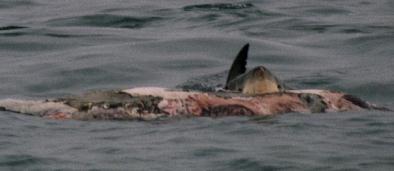
|
(C)JMS |

|
(C)JMS |

|
(C)JMS |
The dorsal fin.
It might be possible to identify this shark as an individual by means of its dorsal fin. Note the carvings on the back side of the fin and its colour pattern.

|
(C)JMS |
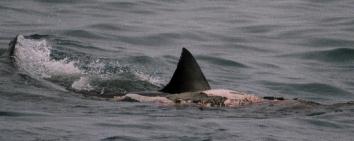
|
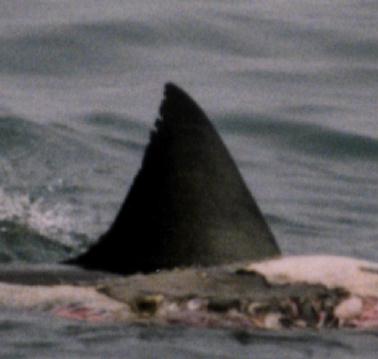
|
(C)JMS |
Behaviour of the shark
Perhaps the most striking observation were the breaks between the bites. It was eating its lunch at its leisure. It is actually a well established that great white sharks can eat for hours on a single kill. I saw a scene like this in a TV documentary a long time ago, but don't take my word for it: see the article about great white sharks in the April 2000 issue of National Geographic magazine (what a coincidence! Somehow NG never ceases to amaze me). The shark must have wandered significant distances away from the carcass at times, because it passed just under the boat at some point. The distance from the carcass can be estimated assuming its length is 3 meter (for a mature female elephant seal). The typical length of the carcass on the pictures is about half the long side of the photo (i.e. one half times 35 mm on the photographic film). For a 400 mm focus, this means that the apparent size (angle) of the carcass was 0.5*35/400= 0.044 radians. For a true length of the carcass of 3 meter, this translates into a distance of 70 meter. If the actual size of the carcass was only 2 meter, the distance would still be 46 meter. To the eye it seemed much closer, but this is deceptive because the height of the observer above the water changes the perspective. Since we were adrift, the distance changed continuously, and at some point we were maybe at half this distance, but 70 meter seems a good average. From this one incident that we saw the shark near the boat, it would seem that the shark wandered more than 50 meters away from its kill between bites. Its feeding pattern looked more like a careful nibble once in a while than an instant violent devouring of its prey.When it was at the carcass, the shark splashed violently with its tail (Figures 5 and 7). This is just what you expect from a shark taking a good bite from its prey. It was still eating when we left it.

|
(C)JMS |
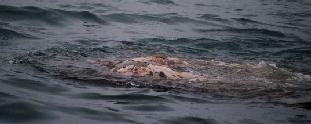
|
(C)JMS |
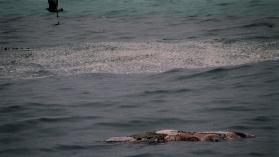
|
The carcass
The carcass itself is interesting because the size of bite marks may help estimate the size of the shark. Figure 10 shows a close-up of the carcass. Note the the marks left by the teeth. Again assuming that the total length of the seal was 3 meter, the three bite marks covering the right half suggest a size of 50cm. At this point, I cannot say what this implies for the size of the shark.

|